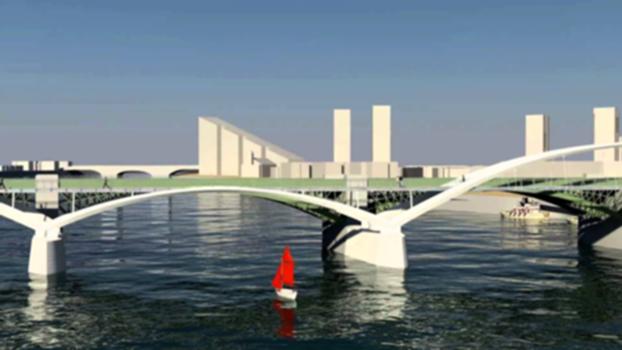General Information
| Other name(s): | Cremorne Footbridge |
|---|---|
| Beginning of works: | 2019 |
| Status: | project phase |
Project Type
| Function / usage: |
Bicycle and pedestrian bridge |
|---|---|
| Structure: |
Half-through arch bridge |
| Material: |
Steel bridge Structurae Plus/Pro - Subscribe Now! |
Location
| Location: |
Wandsworth, London, England, United Kingdom Hammersmith and Fulham, London, England, United Kingdom |
|---|---|
| Crosses: |
|
| Next to: |
Battersea Railway Bridge (1863)
|
| Coordinates: | 51° 28' 22.70" N 0° 10' 45.20" W |
Technical Information
Dimensions
| number of spans | 3 |
Materials
| deck |
steel
|
|---|---|
| piers |
reinforced concrete
|
| arches |
steel
|
Excerpt from Wikipedia
The Diamond Jubilee Footbridge is a proposed pedestrian and cycle bridge over the River Thames in London, England. It is also known as the Cremorne Footbridge and was designed by one-world design architects in conjunction with structural engineers Expedition Engineering and maritime engineers Beckett Rankine. The bridge name commemorates the Diamond Jubilee Celebrations for Queen Elizabeth II, marking the location where she boarded her launch for the start of the Diamond Jubilee river pageant.
Through Community Infrastructure Levy contributions on nearby housing developments Wandsworth Council have around 40% of the funding in place. Piled foundations have been constructed on the Battersea side of the river through a Section 106 Agreement with developer Barratt whilst funding for construction of the rest of the structure is being sought.
Architecture
The style of the bridge is a combination of bright and biomimetic adopting the tensile strength and overall flexibility of a repeating cross-matrix of thin tapering sections. The bridge design has three spans comprising a small central arch flanked by two larger outer arches, supported by four piers. The maximum height of the bridge is 18.41m AOD, rising approximately 4.5m above the neighbouring railway bridge. The primary structure material is painted structural steel and the deck is shared between pedestrians and cyclists.
The three‐span arrangement of the bridge, with larger outer spans and a smaller central span, maintains unobstructed access to the pier at Albion Quay on the south of the river. It also minimises the need for foundations in the river while limiting the structural height so that the bridge does not extend into the airspace required by the nearby Battersea Heliport. The use of diamond‐shaped steel sections both reflects the name of the bridge and allows the arch section size to be varied to provide efficiency, providing material only where it is needed. With the depth of the sections significantly reduced at towards the top of the arches, the long‐views of the bridge will appear particularly elegant.
Planning permissions and construction
The Bridge is supported both by local authority and GLA planning policy. Planning consent has been granted in Wandsworth, Hammersmith & Fulham and by the GLA and TfL. Wandsworth’s Riverside SPD enables the council in future to assign CIL contributions to a bridge and a recent S106 agreement with Barratt London has secured the piling of the bridges foundations on the Battersea side of the river which is now complete.
The developer applied for planning permission in 2012 in both relevant boroughs. In December 2012 the latter borough notified the Mayor of London of a planning application of potential strategic importance to develop the site for the Mayor to make a statement of compliance with The London Plan and to respond. A report for these purposes was prepared by the Planning Decisions Unit of the Greater London Authority. Permissions were received from the London Borough of Wandsworth in June 2013 and from Hammersmith and Fulham in November 2013.
Location and neighbouring bridge
An area kept clear for the eastern bridge footings during a 2017 residential development, immediately adjacent to Battersea Railway Bridge Main article: Battersea railway bridge
The adjoining Battersea Railway Bridge, connected at the feet of the Diamond Jubilee Footbridge has additional piers, is an arch bridge and was opened on 2 March 1863.
Text imported from Wikipedia article "Diamond Jubilee Footbridge" and modified on July 23, 2019 according to the CC-BY-SA 4.0 International license.
Participants
Relevant Web Sites
- About this
data sheet - Structure-ID
20076637 - Published on:
24/01/2019 - Last updated on:
24/01/2019





